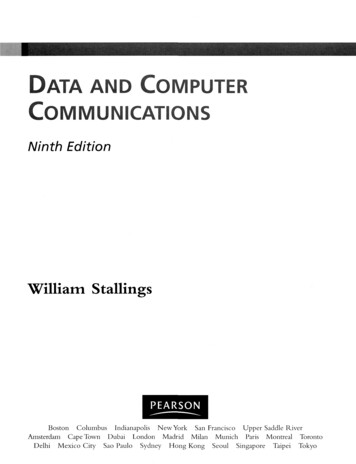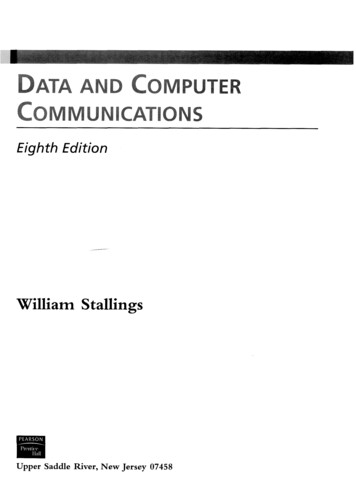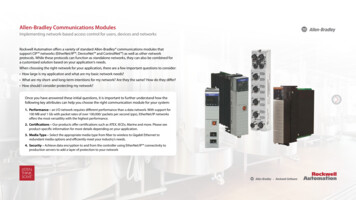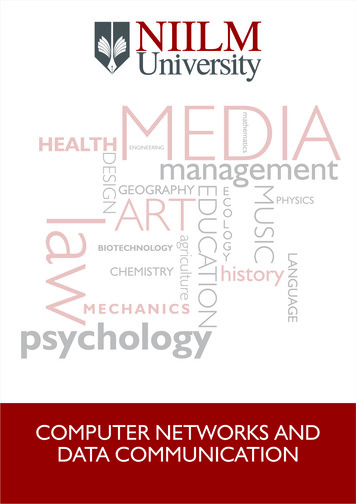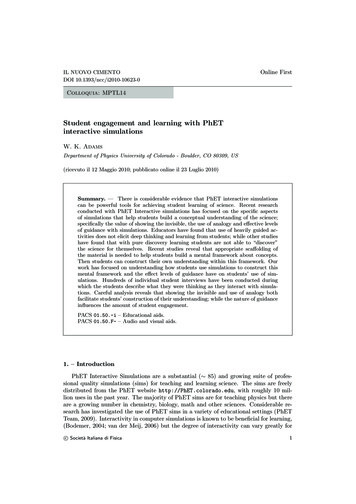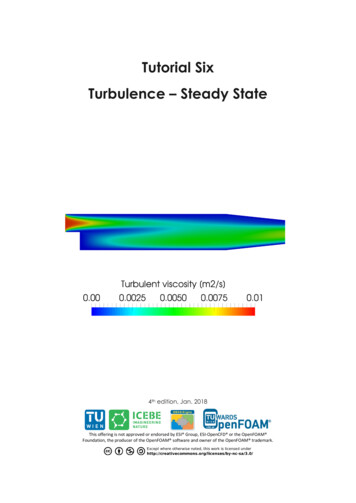
Transcription
19.9.2011Simulation of datacommunications networksT-110.6130 Systems Engineering inData Communications SoftwareZhonghong OuPost-doc researcherData Communications Software Lab,School of Science and Technology, Aalto UniversityZhonghong OuAalto University9/15/20111
19.9.2011AgendaWhatWhenWhyWhoWhereHowZhonghong Ou22
19.9.2011What is simulation? Simulation is the imitation of some real thing, state of affairs,or process. (wikipedia)http://overlayweaver.sourceforge.net/ Simulation is an imitation of a real work process or systemover time. Simulation is the process of designing a model of a realsystem and conducting experiments with this model for thepurpose either of understanding the behavior of the system orof evaluating various strategies (within the limits imposed bya criterion or set of criteria) for the operation of the system.--R.E.ShannonZhonghong Ou33
tionof outer space.(wikipedia)44
19.9.2011Key characteristics Acquisition of valid source information about therelevant selection of key characteristics and behaviors. Use of simplifying approximations and assumptionswithin the simulation.– the assumptions usually take the form of mathematical or logicalrelations. Fidelity and validity of the simulation outcomes.Zhonghong Ou55
19.9.2011Computer simulation A computer program, or network of computers, that attemptsto simulate an abstract model of a particular system. Been used in:– Natural systems Physics (computational physics),Astrophysics,Chemistry,Biology.– Human systems Economics,Psychology,Social science,Engineering.Zhonghong Ou66
19.9.2011Classification (coarse-grained) Physical simulation refers to simulation in which the real thingis substituted for physical objects, which are often chosenbecause they are smaller or cheaper than the actual object orsystem. Interactive simulation is a special kind of physical simulation,often referred to as a human in the loop simulation, in whichphysical simulations include human operators, such as in aflight simulator or a driving simulator.– Human in the loop simulations can include a computer simulationas a so-called synthetic environment;– Hardware in the loop simulation;– Semi-physical simulation;– Half-object simulation.Zhonghong Ou77
19.9.2011Classification (fine-grained) Determinacy:– Stochastic (random) There exists some indeterminacy in its future evolution described by probabilitydistributions; Even if the initial condition (or starting point) is known, there are many possibilities theprocess might go to, but some paths may be more probable and others less so. E.g. stock market, exchange rate.– Deterministic Given a particular input, it will always produce the same output; E.g. mathematical function. Steadiness:– Static (steady) Relating to a given instant of time, time not considered; Used for estimation of quantities from a given distribution;– Dynamic Development of the system based on time; Output changes in a system in response to (usually changing) input signals.Zhonghong Ou88
19.9.2011Classification (fine-grained, cont.) Continuity:–Continuous –In mathematics, a continuous function is a function for which, intuitively, small changes in theinput result in small changes in the output.Considering a function h(t) which describes the height of a growing flower with respect to t.“Analog” system.Discrete The objects studied in discrete simulation– such as integers, graphs, and statements in logic–do not vary smoothly, but have distinct, separated values.“Digital” system.Special case: discrete event simulation (DES)– Managing events in time. The simulator maintains a queue of events sorted by the simulated time theyshould occur, reads the queue and triggers new events as each event is processed. It is not importantto execute the simulation in real time, but rather to be able to access the data produced by thesimulation, to discover logic defects in the design etc. Most computer, logic-test and fault-treesimulations are of this type.Locality:–Distributed –Using a network of interconnected computers to accomplish a common objective or task;Simulations dispersed across multiple host computers.Local Using a single computer to conduct the simulation.Zhonghong Ou99
19.9.2011Classification (fine-grained, icDynamicZhonghong OuDistributedLocal1010
19.9.2011AgendaWhatWhenWhyWhoWhereHowZhonghong Ou1111
19.9.2011When to use simulation? Modeling of natural systems or human systems in order to gaininsight into their functioning. Imitating technology for performance optimization, safetyengineering, testing, training and education, exploring and gainingnew insights into new technology. Showing the eventual real effects of alternative conditions andcourses of action. Estimating the performance of systems too complex for analyticalsolutions. The real system cannot be engaged for reasons, e.g. itmay not be accessible, it may be dangerous or unacceptable toengage, or it may simply not exist.Zhonghong Ou1212
19.9.2011AgendaWhatWhenWhyWhoWhereHowZhonghong Ou1313
19.9.2011Analysis versus simulation Traditionally, the formal modeling of systems has been via amathematical model, which attempts to find analyticalsolutions enabling the prediction of the behavior of thesystem from a set of parameters and initial conditions. Computer simulation is often used as an adjunct to, orsubstitution for, modeling systems for which simple closedform analytic solutions are not possible.– Common feature: attempting to generate a sample ofrepresentative scenarios for a model in which a completeenumeration of all possible states would be prohibitive orimpossible.Zhonghong Ou1414
19.9.2011Analysis versus simulation (cont.) Analysis (two steps):– Modeling of the system as a time-dependent stochastic process;– Analytical solution of the model. Simulation (four steps):––––Modeling of the system as a dynamic stochastic process;Generating realizations of the process;Collecting data (measurement);Statistically analyzing the data and drawing conclusions. Common features:– Modeling is common Differing with respect to details; Mathematical analysis usually utilizing restrictive assumptions.Zhonghong Ou1515
19.9.2011Mathematical analysis Pros:––––Results obtained quickly;Results exact;Giving insight of the system;Allowing optimization. Cons:– Requiring restrictive assumptions;– Analysis complex;– Results (might be) limited to equilibrium state, or averagevalues.Zhonghong Ou1616
19.9.2011Simulation Pros:– No constraints in the model building;– Enabling complex system;– Modeling usually straightforward. Cons:– Time- and energy-consuming;– Results imprecise (precision could be improved by multipleiterations)– Getting insight more difficult;– Optimization more difficult (maybe limited to the trial of a fewparameter combinations).Zhonghong Ou1717
19.9.2011AgendaWhatWhenWhyWhoWhereHowZhonghong Ou1818
19.9.2011Conductor of simulation You Other co-operatorsZhonghong Ou1919
19.9.2011AgendaWhatWhenWhyWhoWhereHowZhonghong Ou2020
19.9.2011Place for simulation Single computer. Cluster of computers.Zhonghong Ou2121
19.9.2011AgendaWhatWhenWhyWhoWhereHowZhonghong Ou2222
19.9.2011How to build simulation model Calibration. Verification. ValidationZhonghong Ou2323
19.9.2011Model calibration Can be achieved by adjusting any available parameters inorder to adjust how the model operates and simulates theprocess. For example, in the simulation of a peer-to-peer (P2P)network, the typical parameters include joining rate, leavingrate, (churn rate), exchanging rate, publishing rate, lookuprate etc. These parameters influence the behaviors of the P2Pnetwork, for instance, lookup success ratio, average trafficload (bytes), and average number of messages.Zhonghong Ou2424
19.9.2011Model verification Can be achieved by obtaining output data from the model andcomparing it to what is expected from the input data. For example, in the simulation of a peer-to-peer (P2P) network, thereare certain expectations with regard to the lookup success ratio, giventhe churn rate, exchanging rate etc. In some cases the system or some part of it can be analyzed undersimplified assumptions. The simulation can be run under the same assumptions; at least theresults should match with each other. In real-life, this is usually not so realistic as it is not easy to get thetheoretical results given the input data.Zhonghong Ou2525
19.9.2011Model validation Can be achieved by comparing the results with what’sexpected based on historical data from the study area. It is the best and most reliable method. Ideally, the model should produce similar results to what hashappened historically. If model output values are drastically different than historicalvalues, it probably means there’s an error in the model. Often difficult to apply, e.g. there is no real system, ormeasurements are too expensive to conduct.Zhonghong Ou2626
19.9.2011What if No simplified mathematical system available, neither nohistorical measurements existing Expert intuition– a common and practical method;– “brain storming” with people who know the system in order todefine sensible assumptions and input data;– an expert can easily recognize “impossible” results;– not so reliable.Zhonghong Ou2727
19.9.2011Selection of languagesGeneral purpose languages(C/C , Java ) Most users have knowledge of at leastone languages; Simulation languages (generalpurpose, GASP, GPSS,SIMSCRIPT, Simula) Supporting many features needed in theprogramming of a simulation model;Available on most computers; Shorter development time; Code easily transported; Lower cost Low cost of the programs; Code running faster;Programming with the aid of the modelingconstructs of the language . Flexible. Requires a lot of programming work; Susceptible to errorsSimulation languages (datacommunications networkoriented, OPNET, QualNet,NS2, OMNET ) Containing network building blocks; Developed specifically for the simulationof data communications networks.Zhonghong Ou2828
19.9.2011Selection of simulators ns-2;ns-3;GloMoSim;OPNet;QualNet;OMNet ;NAB;J-Sim;SimPy;NetHawk Zhonghong Ou2929
19.9.2011ns-2 The de facto standard for network simulation. Its behavior is highly trusted within the networkingcommunity. It was developed at ISI/USC (Information Science Institute, University of Southern California),andwas supported by the DARPA (Defense Advanced Research Projects Agency) and NSF (NationalScience Foundation). ns-2 is a discrete-event simulator organized according to the OSI model and primarily designed tosimulate wired networks. The support for wireless networking had been brought by several extensions. Simulations are based on a combination of C and Otcl (object oriented extension of Tcl createdby David Wetherall at MIT). In general, C is used for implementing protocols and extending thens-2 library. OTcl is used to create and control the simulation environment itself, including theselection of output data. Simulation is run at the packet level, allowing for detailed results. This design choice was originally made to avoid unnecessary recompilations if changes are madeto the simulation set-up. The design of ns-2 trades off simulation performance for the saving ofrecompilations, which is questionable if one is interested in conducting scalable networksimulations. Therefore, ns-2 is currently undergoing a major redesign, one of the maindevelopment goals of its successor, ns-3, is the improvement of simulation performance.Zhonghong Ou3030
19.9.2011ns-2 (cont.) Weaknesses:– Lack of modularity;– Inherent complexity (ns-2 was candidate to be the basis forthe Qualnet simulator but got eventually rejected);– High consumption of computational resources. A harmfulconsequence is that ns-2 lacks scalability, which impedesthe simulation of large networks (ns-2 is typically used forsimulations consisting of no more than a few hundredsnodes).Zhonghong Ou3131
19.9.2011ns-3 Like its predecessor, ns-3 relies on C for the implementation of the simulation models. However, ns-3 no longer uses oTcl scripts to control the simulation, thus avoiding the problemswhich were introduced by the combination of C and oTcl in ns-2. Instead, network simulations in ns-3 can be implemented in pure C , while parts of the simulationoptionally can be realized using Python as well. Moreover, ns-3 integrates architectural concepts and code from GTNetS, a simulator with goodscalability characteristics. These design decisions were made at expense of compatibility. In fact, ns-2 models need to beported to ns-3 in a manual way. Besides performance improvements, the feature set of the simulator is also about to be extended.For example, ns-3 is slated to support the integration of real implementations’ code by providingstandard APIs, such as Berkeley sockets or POSIX threads, which are transparently mapped tothe simulation.Zhonghong Ou3232
19.9.2011GloMoSim GloMoSim was developed in 1998 at UCLA (University of California, Los Angeles) for mobilewireless networks. It is written in Parsec, which is an extension of C for parallel programming, and benefits fromParsec’s ability to run on shared-memory symmetric processor (SMP) computers. New protocolsand modules must be written in Parsec too. Respects OSI model. GloMoSim is designed to be extensible, with all protocols implemented asmodules in the GloMoSim library. Capable of supporting parallel environment. The network is split into different sub-networks, eachof them being simulated by distinct processors. The network is partitioned in such a way that thenumber of nodes simulated by each partition is homogeneous. GloMoSim uses an object-oriented approach. However, the designers realized that a purelyobject-oriented approach would not be scalable. Instead, GloMoSim partitions the nodes, andeach object is responsible for running one layer in the protocol stack of every node for its givenpartition. This helps to ease the overhead of a large network. Weaknesses:––While effective for simulating IP networks, it is not capable of simulating any other type of network.Lack of a good and in-depth documentation. GloMoSim stopped releasing updates in 2000. Instead, it waschosen as the core of the commercial QualNet simulator, and is now updated as QualNet.Zhonghong Ou3333
19.9.2011GloMoSim (cont.)Fig. GloMoSim architectureZhonghong Ou3434
19.9.2011OPNet Optimized Network Engineering Tools (OPNet) is a discrete-eventnetwork simulator first proposed by MIT in 1986, written in C . Itis a well-established and widely used commercial suite for networksimulation. It uses a hierarchical model to define each aspect of the system.–––– The top level consists of the network model, where topology is designed;The next level is the node level, where data flow models are defined;A third level is the process editor, which handles control flow models.Finally, a parameter editor is included to support the three higher levels.The hierarchical model results in an event queue for the discreteevent simulation engine and a set of entities representing thenodes that will be handling the events. Each entity in the systemconsists of a finite state machine which processes the eventsduring simulation.Zhonghong Ou3535
19.9.2011OPNet (cont.) Pros:– Capable of executing and monitoring several scenarios in aconcurrent manner;– Supporting the use of modeling different sensor-specifichardware, such as physical-link transceivers and antennas;– Supporting custom packet formats;– Graphical interface to develop models, also can be used tomodel, graph, and animate the resulting output. Cons:– Suffering from the same object-oriented scalability problems asns-2.– Not supporting as many protocols as ns-2 because of itscommercial feature.Zhonghong Ou3636
19.9.2011QualNet A commercial ad hoc network simulator based on theGloMoSim core. It extends the GloMoSim offering by bringing support, adecent documentation, a complete set of user-friendlytools for building scenarios and analyzing simulationoutput. QualNet also extends the set of models and protocolssupported by the initial GloMoSim distribution. As it is built on top of GloMoSim, QualNet is written inParsec.Zhonghong Ou3737
19.9.2011QualNet (interface)Zhonghong Ou3838
19.9.2011OMNeT In contrast to ns-2 and ns-3, OMNeT is not a network simulator by definition, but ageneral purpose discrete event-based simulation framework, based on objectoriented design. It is mostly applied to the domain of network simulation, given the fact that with itsINET package it provides a comprehensive collection of Internet protocol models.–The INET Framework contains models for several wired and wireless networking protocols,including UDP, TCP, SCTP, IP, IPv6, Ethernet, PPP, 802.11, MPLS, OSPF, and many others. In addition, other model packages such as the OMNeT Mobility Framework andCastalia facilitate the simulation of mobile ad hoc networks or wireless sensornetworks. OMNeT simulations consist of so-called simple modules (C ) which realize theatomic behavior of a model, e.g. a particular protocol. Multiple simple modules can belinked together and form a compound module. OMNeT utilizes NED (NEtwork Description) language to combine the simplemodules into compound modules and define the network topologies. NED istransparently rendered into C code when the simulation is compiled as a whole.Zhonghong Ou3939
19.9.2011NAB Network in A Box (NAB) is a discrete event simulatordeveloped at EPFL (Lausanne, Switzerland). NAB is dedicated to MANETs simulation. NAB is focusing on scalability and visualization andfeatures a very realistic mobility model (a constrainedwaypoint based on city maps). NAB’s design is node-oriented (and object-oriented); thatis each node is represented by an object. It is written inOCaml. It is open source.Zhonghong Ou4040
19.9.2011J-Sim J-Sim, developed at University of Illinois at Urbana-Champaign, is a general purposeJava-based simulator modeled after ns-2. Unlike ns-2, J-Sim uses the concept of components, replacing the notion that eachnode should be represented as an object. J-Sim uses three top level components, each component is broken into different partsand modeled differently within the simulator:––– Pros:–– the target node (which produces stimuli);the sensor node (that reacts to the stimuli);the sink node (the ultimate destination for stimuli reporting).Component-based architecture scales better than the object oriented model used by ns-2and other simulators.Applications may be simulated, and there is support for the connection of real hardwaresensors to the simulator.Cons:––Relatively complicated to use;Faces its share of inefficiencies. Java, in general, is arguably less efficient than many otherlanguages.Zhonghong Ou4141
19.9.2011JiST Java in Simulation Time (JiST) allows the implementation of network simulations instandard Java. It is mostly used in conjunction with SWANS, a simulator for mobilead hoc networks built on top of JiST. Network simulations in JiST are made up of entities which represent the networkelements, for example nodes, with simulation events being formed by methodinvocations among those entities. The entities advance the simulation time independently by notifying the simulationcore. While the code inside an entity is executed like any arbitrary Java program, only theinteractions between the individual entities are carried out in simulation time. The interactions between entities correspond to synchronization points and facilitatethe parallel execution of code at different entities, resulting in a potential performancegain. The official development of JiST has stalled, as it is no longer maintained by itsoriginal author, Rimon Barr.Zhonghong Ou4242
19.9.2011SimPy SimPy is a process-oriented discrete-event simulator; Unlike the other simulators, no public available network modelsexist for SimPy. Instead, it is a bare simulation API written inPython. In SimPy, the basic simulation entities are processes. They areexecuted in parallel and may exchange Python objects amongeach other. Most processes include an infinite loop in which the main actions ofthe process are performed. Besides abstractions for processes and the related exchange ofobjects, SimPy provides instructions for the synchronization ofsimulation processes and commands for the monitoring ofsimulation data.Zhonghong Ou4343
19.9.2011NetHawk EAST Environment for Automated Systems Testing (EAST) is a testautomation and traffic generation tool that allows users toemulate/simulate one or more network elements in thetelecommunications network. EAST can be used for feature testing as well as load testing. EAST provides an easy to use, intuitive GUI front-end that isconsistent across all protocols. The EAST GUI is JAVA based and hence platform independent. NetHawk was originally based in Oulu, and was acquired byEXFO (Canadian company) on March 12, 2010.Zhonghong Ou4444
19.9.2011NetHawk EAST (cont.)Zhonghong Ou4545
19.9.2011Matlab MATLAB (matrix laboratory) is a numerical computingenvironment and fourth-generation programming language. It was originally designed to solve linear algebra type problemsusing matrices. Developed by MathWorks, MATLAB allows:–––– matrix manipulations;plotting of functions and data;implementation of algorithms;creation of user interfaces, and interfacing with programs written inother languages, including C/C , Java, SQL, and Fortran etc.Commercial product, but widely used in industry and academia.– Many algorithms and toolboxes freely availableZhonghong Ou4646
19.9.2011Granularity and mobilityZhonghong Ou4747
19.9.2011Parallelism and interfaceZhonghong Ou4848
19.9.2011Popularity and licenseZhonghong Ou4949
19.9.2011PopularitySimulation result of 2000-2005 proceedings of the MobiHoc conferenceZhonghong Ou5050
19.9.2011Pitfalls of simulation Simulation setup– Simulation type: Dynamic vs. steady-state (execute one type of simulation and report resultson the other type of simulation).– Model validation & verification: Execute simulations with a model that has not been validated in the specificenvironment.– PRNG (Pseudo Random Number Generator) validation & verification: Someone [9] estimates that the NS-2 PRNG is only valid for severalthousand numbers.– Variable definition: There are 674 variables defined in the ns-default.tcl file of NS-2.27.– Scenario development: Lack of independence between parameters; Lack of rigorous scenarios, no benchmark scenarios.Zhonghong Ou5151
19.9.2011Simulation execution Setting the PRNG seed:– Not setting properly, NS-2 uses a default seed of 12345 foreach simulation run; Scenario initialization:– Most simulations start with empty caches, queues, andtables, determining and reaching the steady-state level ofactivity is part of the initialization. Metric collection:– Output needs to be in line with the required granularity.Zhonghong Ou5252
19.9.2011Output analysis Single set of data:– Taking the first set of results from a simulation and accepting theresults as “truth”. Statistical analysis:– Not using the correct statistical formulas with the different forms ofoutput. Confidence intervals:– A culmination of several of the previous analysis issues.– Confidence intervals account for the randomness and varied outputfrom a stochastic simulation. Publishing:– The lack of consistency in publishing simulation based study resultsdirectly impacts the trustworthiness of these studies.– A new researcher cannot repeat the studies to start his or her ownfollow-on research.Zhonghong Ou5353
19.9.2011Conclusion Each of the pitfalls discussed takes away from thegoals of making the statistically sound. It is still a long way to go!!!http://www.youtube.com/watch?v cddIgb1nGJ8Zhonghong Ou5454
19.9.2011References 1. Pasi Lassila. S-38.3148 Simulation of Data Networks.2. Wikipedia. http://en.wikipedia.org/wiki/Simulation.3. Wikipedia. http://en.wikipedia.org/wiki/Computer simulation.4. Weingartner E, vom Lehn H & Wehrle K (2009) A Performance Comparison of RecentNetwork Simulators. IEEE International Conference on Communications (ICC '09):1-5.5. Dalimir Orfanus, Johannes Lessmann, Peter Janacik, Lazar Lachev (2008)Performance of wireless network simulators: a case study. Proceedings of the 3nd ACMworkshop on Performance monitoring and measurement of heterogeneous wireless andwired networks (PM2HW2N '08): 59-66.6. D. Curren. A survey of simulation in sensor networks. Student project,www.cs.binghamton.edu/ kang/teaching/cs580s/david.pdf,2007.7. Stuart Kurkowski, Tracy Camp & Michael Colagrosso (2005) MANET simulation studies:the incredibles. ACM SIGMOBILE Mobile Computing and Communications Review 9(4):50-61.8. Wikipedia. http://en.wikipedia.org/wiki/MATLAB.9. K. Pawlikowski, J. Jeong, and R. Lee. Letters to the editor. IEEE CommunicationsMagazine, pages 132–139, 2002.Zhonghong Ou5555
19.9.2011Contact Information Course web page: https://noppa.tkk.fi/noppa/kurssi/t-110.6130/ Contact email: zhonghong.ou@aalto.fi Office hour: Fri 10-11 room A 109 Qustions & Suggestions?Zhonghong Ou5656
Simulation of data communications networks T-110.6130 Systems Engineering in Data Communications Software Zhonghong Ou Post-doc researcher Data Communications Software Lab, School of Science and Technology, Aalto University . Its behavior is highly trusted within the networking community. It was developed at ISI/USC (Information Science .
